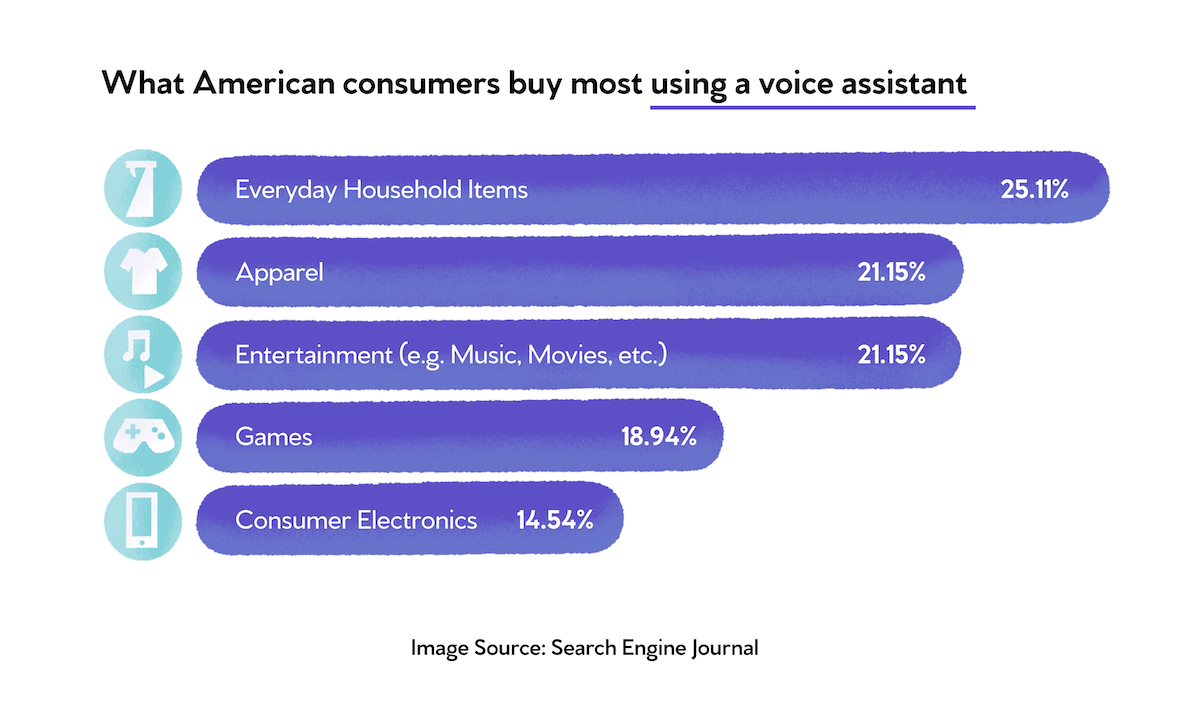An Overview of Voice-Enabled Purchasing & 5 Ways to Prepare Your Store

The development of smart speakers — as well as improved voice recognition technology for mobile devices — has opened up a whole new way to shop online. Instead of using a keyboard to navigate ecommerce sites, consumers can now simply say what they want out loud to place an order.
With that level of convenience, it should be no surprise that voice assistants are becoming more popular.
Indeed, 111.8 million people in the U.S. (33.8% of the population) used a voice assistant on at least a monthly basis in 2019. And this figure is expected to grow to 122.7 million people (36.6% of the population) in 2021.

As far as ecommerce goes, voice assistants are expected to generate $80 billion in annual sales by 2023. By making your site compatible with voice assistant technology, you very well may be able to significantly increase your revenue.
In this guide, we’ll answer a few of the most commonly asked questions about this new technology. Then, we’ll show you the adjustments you need to make to your store in order to get a piece of that $80 billion pie.
What are Smart Speakers and How Do They Work?
Before we dive in, let's address the basics.
A smart speaker is a device that combines a speaker with a voice command interface and integrated virtual assistant software. While traditional speakers are only capable of audio playback, smart speakers offer many additional features.
With voice commands, users can immediately hear the answers to questions like, "What is the weather today?" They can also use their voice to perform tasks, such as setting an alarm and updating a virtual calendar. And in terms of ecommerce, shoppers can use a smart speaker to make online purchases, completely hands-free.
There are several technologies that go into making smart speakers work, including:
- Wi-Fi: Of course, a smart speaker must be able to get on the internet in order to answer questions for users. Smart speakers have built-in adapters, similar to laptops and smartphones, that allow them to connect to wireless networks.
- NLP: All smart speakers are equipped with microphones, which enable them to receive voice commands. On the software side, virtual assistants, such as Google Assistant and Amazon Alexa, use natural language processing (NLP) technology to understand the complexities of spoken language and determine how the device should respond to such commands.
- Bluetooth: Some smart speakers are also equipped with Bluetooth technology, which allows them to connect to other devices in the user’s home. For example, by connecting a smart speaker to a smart thermostat over a Bluetooth connection, users could raise or lower the temperature in their home with a voice command.
Who is Using Smart Speakers?
Smart speaker users are disproportionately male — to the tune of 70%.
If your store’s focus is on products that are particularly popular with men, then preparing your site for voice purchases should absolutely be a priority.
It should also be noted that smart speaker use is far from limited to the United States. While this technology is most common in the U.S., it’s fairly popular all around the world, from Canada (12.6 million monthly users in 2019) to Germany (11.7 million users) to China (85.5 million users), according to eMarketer.
What Kind of Products are Being Ordered?
A survey of 1,203 U.S. voice assistant users found that household items, apparel and entertainment are the types of products most commonly purchased using voice assistant technology, with over 20% of users making a purchase in each of these categories.

Another trend that clearly stands out: Expensive products, such as furniture and appliances, are purchased less often than most other types of products (less than 10% of voice assistant users made a purchase in either of these categories).
This is likely due to the fact that people will put much more research into expensive products. More affordable products aren’t going to have much of an impact on a person’s budget, so there’s no reason not to just place them on the fly with a voice command. Expensive products are more of a financial commitment, and when you’re already using a keyboard to read up on your options and confirm that you’re making the right choice, you might as well just make the purchase manually, too.
Who are the Leaders in Voice Purchase Tech?
With a 70% market share for smart speakers, Amazon is the clear leader of this tech niche. But Google, which has around a 30% market share, has developed a secret weapon that just might allow it to close the gap with Amazon.
That secret weapon is Voice Match, which will make it much easier to purchase items with Google Assistant software. Previously, Google Assistant users had to verify such purchases with their fingerprints or facial recognition. This extra step greatly diminished the convenience of voice commerce — which is, of course, its biggest asset as a purchasing channel.
Now, with Voice Match, Google Assistant will be able to recognize the voice of the user to verify that no fraud is taking place. And when it comes to processing different languages, Voice Match has a higher accuracy rate than Amazon’s Alexa software. It can even tell the difference between variations of the same language (American English vs. British English, etc.).
Another company that deserves recognition in this area is Sonos. It may not be a household name like Amazon or Google, but the quality of this brand’s smart speakers has earned high praise from leading tech publications. In 2020, the Sonos One was named “Best sound quality for the price” by CNET and “Best Overall” smart speaker by Wired. Also, Consumer Reports gave the Sonos Move the distinction of “Best Portable Smart Speaker.”
How Safe is it to Use Smart Speakers?
As with any device that connects to the internet, it is possible for smart speakers to be hacked. And this can be an especially serious concern for smart speakers, as they are often connected to home security systems.
Another issue with smart speakers is accidental activation. The microphones installed in these devices are always passively listening, and when they hear a predetermined wake word (for example, "Hey Siri" for the Apple HomePod), they switch over to active listening and begin recording audio.
But smart speaker tech has not yet been perfected — words and phrases similar to wake words that happen to come up in private conversation or even dialogue on TV activate smart speakers fairly frequently. It was recently leaked that smart speaker manufacturers have human agents listen to recorded audio for quality control, which raises obvious privacy concerns given that devices can be activated without the user’s knowledge or consent.
To address these privacy concerns, users would be wise to mute their smart speaker's microphone when they don't plan on using voice commands for an extended period of time.
Furthermore, to prevent their device from being hacked, users should set up their own username and password as soon as possible. There are special search engines that criminals can use to find the default login credentials of popular smart speakers and other devices, which can then give them access to all kinds of sensitive information. Immediately customizing credentials will nip this problem in the bud.
5 Ways to Prepare Your Store for Voice Purchases
People tend to phrase their thoughts differently when they say them out loud rather than type them out. There’s a bit of a filtering process that takes place here — for each word that a user chooses to include in a text search, they consciously chose not to use any similar words instead (they will generally use fewer words as well). But when someone is talking, the words flow out more naturally, often without these choices being made.
For example, a person might write “sushi restaurant Seattle” into the search bar on Google’s homepage, but say, “Which sushi restaurants are open right now in Seattle?” when conducting the same search via Google Assistant.
Because of this difference, as well as other factors involved with voice search and purchasing, you will likely need to make the following changes to your store’s content and marketing strategy in order to attract more voice assistant users:
- Make your content more conversational: To match the more informal style of voice searches, your content will need to also be idiomatic. So, make an effort not to be overly concise. And if you already produce videos or podcasts as part of your marketing strategy, publishing transcriptions of this material will provide you with content that’s conversational by default.
- Target long-tail keywords: There are two types of keywords you can target with your SEO strategy — short-tail keywords, which are high-volume but competitive, and long-tail keywords, which are low-volume but less competitive. Another advantage to long-tail keywords is that they are ideal for the full sentence format of voice searches.
- List your products on Google Shopping: If your online store has a brick-and-mortar counterpart, then you should take advantage of the fact that Google Assistant will share results from Google Shopping, which is a service that allows users to browse products that are only available in-store.
- Develop an Alexa Skill:Alexa Skills are essentially apps for Amazon smart speakers. While they do require some time and money to develop, that investment should be well worth the number of people that it directs to your products. For example, the Campbell’s Kitchen skill provides users with recipes and other cooking-related pieces of content (which all feature Campbell’s products, of course).
- Earn the Amazon’s Choice badge for your products: When Alexa users search for a product without specifying a brand, most of the time Alexa will present them with an Amazon’s Choice product. Your products will need to have a low return rate and high average rating (and be Prime-eligible) for you to earn this badge.
Conclusion
When ecommerce first started, there were only a handful of ways for potential customers to discover your ecommerce site. But the development of new technology such as smart speakers provides additional channels for you to explore, which presents an opportunity to make your store much more successful.
So, are you ready to increase your revenue through voice purchases? With the help of these tips, you’ll be able to make the most of this newer, growing purchasing channel.

Adam Ritchie
Adam Ritchie is a writer based in Silver Spring, Maryland. He writes about ecommerce trends and best practices for Shogun. His previous clients include Groupon, Clutch and New Theory.



